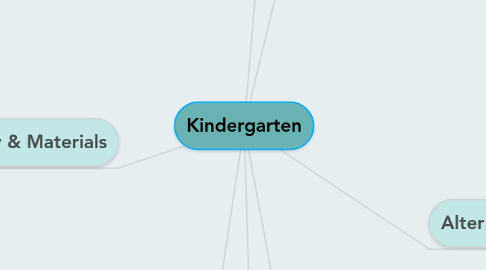
1. Play & Materials
1.1. For all areas of development
1.1.1. Aesthetic and Artistic
1.1.2. Social and Emotional
1.1.3. Intellectual
1.1.4. Physical
1.1.5. Social Responsibility
1.2. Developmentally Appropriate Practice
1.2.1. Carpet/Circle Time
1.2.2. Songs, stories, poetry, music
1.2.3. Routines
1.2.4. Large group lessons
1.2.5. Centre time
1.2.5.1. Free Choice
1.2.5.2. Set activities
1.3. Types of Play
1.3.1. Rough & Tumble
1.3.2. Risk taking
1.3.3. Creative
1.3.4. Socio-dramatic
1.3.5. Social
1.3.6. Dramatic
1.3.7. Imaginative
1.3.8. Large-motor
1.3.9. Small-motor
1.3.10. Language
1.3.11. Inclusive
1.3.12. Literacy
1.3.13. Numeracy
1.3.14. Games/Rules
1.3.15. Constructive
1.3.16. Exploratory
1.3.17. Sensory
1.3.18. Physical
1.3.19. and More...
1.4. Materials
1.4.1. Change / add materials to stimulate interest and curiosity
1.4.2. Based on student interests
1.4.3. Magical / Mystical / Delicate
1.4.3.1. Belief that they are capable
2. Classroom Environment
2.1. Reggio Emilia
2.1.1. Environment as 3rd teacher
2.1.2. "Home away from home"
2.1.2.1. Connection to families
2.1.2.2. Family tree
2.1.3. Children are capable
2.1.3.1. glass
2.1.3.2. mirrors
2.1.3.3. mosaic tiles
2.1.4. Provocations
2.1.5. Inquiry
2.1.6. Loose parts
2.1.6.1. Natural materials
2.1.6.2. Open ended
2.1.7. Light table
2.1.8. Displays of work
2.1.8.1. I Wonder Wall
2.1.9. Plants
2.1.10. Natural light
2.2. Nature
2.2.1. Exploring nature daily
2.2.2. Natural curiosity
2.2.2.1. Wonder
2.2.2.2. Inquire
2.2.2.3. Experiment
2.2.3. Development and Gains
2.2.3.1. Locomotor skills
2.2.3.2. Assertiveness
2.2.3.3. Cooperation
2.2.3.4. Self control
2.2.3.5. Self reflection
2.3. Visual / Physical
2.3.1. Materials accessible to children
2.3.2. Comfortable
2.3.3. Displays - appealing, but not overstimulating
2.3.3.1. Created by students
2.3.3.2. Student work displayed
2.3.4. Cubbies - a place for students' belongings
2.3.5. Connection to families & cultures
2.3.6. Spaces - organized by "type", activity level and volume
2.3.6.1. Large group area
2.3.6.2. Spaces for wet/messy activities
2.4. More
2.4.1. Organized
2.4.2. Predictable routines
2.4.3. Expectations
2.4.4. Mutual respect
2.4.5. Foster positive relationships
2.4.6. Children are valued
2.4.7. Children are capable
2.4.8. Children are celebrated
3. Observing, Collecting, Recording, Assessing
3.1. Learning is an active process
3.2. Assessment
3.2.1. Is:
3.2.1.1. Gather, record, analyze data about progress and achievement
3.2.2. Assess using:
3.2.2.1. Anecdotal records
3.2.2.2. Observation checklists
3.2.2.3. Continuums
3.2.2.4. Rating scales
3.2.2.5. Documentation
3.2.2.6. Interviews
3.3. Evaluation
3.3.1. Is:
3.3.1.1. making judgement and decisions on interpretation of accumulated data
3.3.2. Evaluate by:
3.3.2.1. providing marks and comments
3.3.2.1.1. Report cards
3.3.2.1.2. Parent teacher meetings
3.3.2.1.3. IEPs
3.3.2.1.4. School Based Team meetings
3.3.3. Types
3.3.3.1. Formative
3.3.3.2. Summative
3.3.3.3. Diagnostic
3.4. Reporting
3.4.1. Is:
3.4.1.1. Sharing information
3.4.1.2. To gain a stronger awareness of learning and ways to support learning
3.4.2. 3 Formal
3.4.3. 2 Informal
4. Readiness & Transitions
4.1. Having the ability to learn and cope with the school environment without undue stress
4.2. Each learner is unique
4.3. Skills
4.3.1. Social / Emotional
4.3.1.1. includes ability to self-regulate
4.3.2. Intellectual
4.3.3. Physical
4.4. Programs & Initiatives
4.4.1. Welcome to Kindergarten
4.4.2. Strong Start
4.4.3. Ready, Set, Learn
4.4.4. Early Years Framework
4.4.5. Full Day Kindergarten Program Guide & Parent Pamphlet
4.5. Flexibility & working in conjunction with families and what's appropriate for each individual child
5. Schedules, Transitions, & Centres
5.1. Schedules
5.1.1. Play times
5.1.1.1. Self Directed
5.1.1.2. Teacher Directed
5.1.2. Gross motor movement
5.1.2.1. DPA
5.1.2.2. PE
5.1.2.3. Recess
5.1.2.4. Songs, games...
5.1.3. Fine motor movement
5.1.4. Group / Shared experiences
5.1.5. Quiet Time
5.2. Centres
5.2.1. Types of Centres
5.2.1.1. Manipulative
5.2.1.2. Sand / Water
5.2.1.3. Building
5.2.1.4. Science / Nature
5.2.1.5. Dramatic Play
5.2.1.6. Creative
5.2.1.7. Outdoor
5.2.1.8. Language and Literacy
5.2.1.9. Numeracy
5.2.1.10. Book / Quiet area
5.2.1.11. Listening
5.2.1.12. Music / Movement
5.2.1.13. Puzzles / Games
5.2.2. Labelled with learning (Coquitlam district)
5.2.3. Change/add materials based on students' interests and to promote inquiry
6. Alternative Approaches
6.1. Waldorf
6.1.1. Developing Intellectual in harmony with emotional and physical nature... Holistic education
6.1.2. Imagination, creative play, teamwork
6.1.3. Natural materials: feel, sight, smell
6.1.4. Artistic
6.2. Montessori
6.2.1. Prepared materials, designed for self directed learning
6.2.2. Orderly series of structured learning activities
6.2.3. Child's own pace
6.2.4. Initiative and independence
6.3. International Baccalaureate
6.3.1. Who we are
6.3.2. How the world works
6.3.3. Where we are in place and time
6.3.4. How we express ourselves
6.3.5. How we organize ourselves
6.3.6. Sharing the planet
6.3.7. Dynamic, sharing of ideas, inquiry and natural curiosity
6.4. Reggio Emilia
6.4.1. Respect, responsibility, community
6.4.2. Exploration, discovery based on interests of children
6.4.3. Self guided curriculum
6.4.4. Critical thinking and collaboration
6.4.5. Art
6.4.6. Children are honored and respected
6.4.7. Documentation (writing, photos, collections) - displayed
6.5. French Immersion
7. Communicating with Families
7.1. Parents - child's first teacher
7.1.1. Parents have the right to be involved
7.2. Partnership / Mutuality
7.2.1. Teamwork
7.3. Open and sincere
7.3.1. Empathy
7.4. Initiated from the start
7.4.1. Establishing a positive relationship and opening positive lines of communication from the start, can help with having "challenging" conversations later
7.5. Share success stories, & praise for their child
7.6. Ways to communicate
7.6.1. In person
7.6.2. Telephone
7.6.3. Email
7.6.4. Class blog
7.6.5. Back and Forth books
7.6.6. Notes
7.6.7. Meetings
7.6.8. Newsletters
7.7. Conferences
7.7.1. Student led
7.7.2. Parent-Teacher
7.7.3. 3 Way
7.7.4. Goal Settinng

